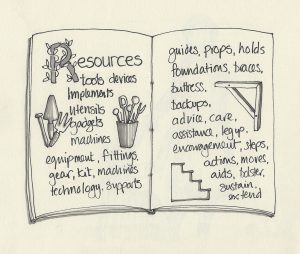 Here is a version of the slides and notes I have used to make the case for intervening on bullying and incivility, and explain why reducing the use of these behaviours is necessary and so difficult. More importantly, to help people to examine and evaluate their work culture and any intention to try different ways of working and talking to get the work done.
Here is a version of the slides and notes I have used to make the case for intervening on bullying and incivility, and explain why reducing the use of these behaviours is necessary and so difficult. More importantly, to help people to examine and evaluate their work culture and any intention to try different ways of working and talking to get the work done.
The ideas presented are a mix of people’s work and my doctoral thesis, that explored the capacity and skill of being ‘constructively awkward’. I have a particular debt to my colleagues, Sarah Garrett, Prof Suzette Woodward, Stafford Scott and Dr Philip Boxer. It is hard to underestimate the value of a good companion and relevant background theory to keep you thinking and steady as you go into the contested territory of bullying and incivility.
The slides are an excuse for an inquiry-based conversation. The notes are at best, a set of catalytic ideas to support such a conversation.
What’s here
- Mapping what gets silenced – A way of investigating what can be left out when people talk about their work, given our tendency to guard what we say and the pressure we can be under to say everything is fine. The concept of psychological safety is introduced as a necessary condition for saying more. See ‘Mapping what gets silenced’ slides and notes here.
- How we talk matters – A summary of the literature to argue the negative effects and costs of bullying and incivility on people’s capacity to think, cooperate and align their efforts with others. See ‘How we talk matters’ slides and notes here.
- How we can go silent – Explores how we can both be silenced and silence ourselves, and the consequences for how to speak to what we notice. An explanation of why it can be hard to go against the grain of taken for granted ways of thinking and behaving. See ‘How we can go silent’ slides and notes here.
- Refusing to go quietly – Suggests how we can resist being silenced; how we can be ‘constructively awkward’. That is by speaking to who and what may be being ignored or silenced, but in a way that keeps it civil, thoughtful and encouraging. See ‘Refusing to go quietly’ slides and notes here.
Facilitation warning
If you are thinking of using these slides and notes to lead a project to investigate and reduce bullying and incivility then these three points may be useful.
- Risks and mitigation – Leading a conversation about the effects of bullying and incivility will remind some people of what they have been on the receiving end of. They may forcefully re-experience the situation. A statement about this possibility should be made. If there are resources to help, people should be alerted to them. People should be reminded that such a conversation or workshop should be run under the Chatham House Rule (see section 1/slide 2) The important thing is to normalise this reaction and give people the time and space to express themselves if you think it is safe enough. Otherwise, let people know they can talk afterwards. There is nothing to be ashamed of. The evidence to be discussed, shows we all react with a degree of self-blame and shame when on the receiving end of poor behaviours.
- Disclosure – You should also assume that some people will recognise their poor behaviour. Again, this possibility should be spoken about. As in, ‘there for the grace of God go I’. A personal disclosure can help people believe it may be ok to talk about their behaviour. You will need to encourage an inquiry approach to whatever is raised. It is not enough to say I’m just a bad person. Behaviour is mediated by role and what is going on in the wider system. Bullying and incivility have a system purpose and it is only by understanding this, that the pressure to behave badly can be reduced. Only a very few gain their pleasure from being abusive.
- Impact – Don’t expect to be thanked. An inquiry into these behaviours, even when requested, usually triggers a moment of ambivalence. Often most acutely felt by the senior leadership. It will no longer be possible to sustain a view of the organisation as essentially benign. A case of being careful for what you wish for. Again, this is best-discussed early in the work.
For more ideas and information about leading a project to investigate and reduce bullying and incivility have a look at my leadership guide here.